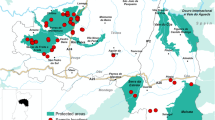Abstract
Several coprological studies of Alouatta pigra, the black howler monkey, inhabiting Belize and Mexico have been published in the past several years. Trematodes, specifically Controrchis biliophilus (Dicrocoeliidae), have been detected in A. pigra from all locations in Belize and Mexico examined in those studies. A routine coprological survey of A. pigra was conducted in May and June 2010 as part of baseline data collection for an A. pigra population in Punta Gorda, Toledo District, southern Belize. The 51 fecal samples collected in this area were all negative for C. biliophilus. Subsequently, two additional fecal samples were collected from another population of A. pigra in Toledo District and 25 additional fecal samples were collected from six other areas of Belize during December 2010 and January 2011 and were examined for parasites. To date, C. biliophilus eggs have been detected in fecal samples from A. pigra inhabiting every district of Belize except Toledo District in southern Belize. This finding is notable, for no other population of A. pigra completely free of C. biliophilus infection had been located prior to this study.

Similar content being viewed by others
References
Bonilla-Sánchez YM, Serio-Silva JC, Pozo-Montuy G, Bynum N (2010) Population status and identification of potential habitats for the conservation of the endangered black howler monkey, Alouatta pigra, in Northern Chiapas, Mexico. Oryx 44:293–299
Bowman DD, Georgi JR (2008) Georgi’s parasitology for Veterinarians. WB Saunders Co, St. Louis
Brockett R (2001) Reproductive seasonality in the Belizean black howling monkey (Alouatta pigra). Neotropical Primates 8:136–138
Chapman CA, Gillespie TR, Goldberg TL (2005) Primates and the ecology of their infectious diseases: how will anthropogenic change affect host-parasite interactions? Evol Anthropol 14:134–144
Eckert KA, Hahn NE, Genz A, Kitchen DM, Stuart MD, Averbeck GA, Stromberg BE, Markowitz H (2006) Coprological surveys of Alouatta pigra at two sites in Belize. Int J Primatol 27:227–238
Gillespie TR, Nunn CL, Leendertz FH (2008) Integrative approaches to the study of primate infectious disease: implications for biodiversity conservation and global health. Am J Phys Anthropol Suppl 47:53–69
Horwich RH, Lyon J (1990) A Belizean Rainforest: The Community Baboon Sanctuary, 3rd edn. Orang-utan Press, Gays Mills
Pavelka MSM (2011) Mechanisms of Cohesion in Black Howler Monkeys. Pages 167–178 in RW Sussman and CR Cloninger (eds) Origins of Altruism and Cooperation. Springer, New York. Retrieved August 8, 2011, from http://www.springerlink.com.mutex.gmu.edu/content/g0656nvm42273457/
Portig WH (1965) Central American Rainfall. Geogr Rev 55:68–90
Silver SC, Ostro LE, Yeager CP, Horwich R (1998) Feeding ecology of the black howler monkey (Alouatta pigra) in northern Belize. Am J Primatol 45:263–279
Trejo-Macías G, Estrada A, Mosqueda Cabrera M (2007) Survey of Helminth Parasites in Populations of Alouatta palliata mexicana and A. pigra in Continuous and in Fragmented Habitat in Southern Mexico. Int J Primatol 28:931–945
Van Belle S, Estrada A, Ziegler TE, Strier KB (2009) Sexual behavior across ovarian cycles in wild black howler monkeys (Alouatta pigra): male mate guarding and female mate choice. Am J Primatol 71:153–164
Vitazkova SK (2005) Demographic and ecological factors affecting the parasites of free-ranging black howler monkeys, Alouatta pigra, from Belize and Mexico. Ph.D., Columbia University, New York, NY
Vitazkova SK, Wade SE (2006) Parasites of free-ranging black howler monkeys (Alouatta pigra) from Belize and Mexico. Am J Primatol 68:1089–1097
Acknowledgments
The authors thank R. N. Castellanos for invaluable field assistance without which this research could not have been possible. Sincere thanks to Ian and Kate Morton of Hickatee Cottages for permission to collect samples on their property, enthusiastic and material support of our various research projects, and their commitment to conservation in Belize; to Ian and Ella at Ian Anderson’s Caves Branch for their hospitality, interest, and permission to collect samples on their property; managers at Tranquility Lodge, Chan Chich Lodge, and Belize Audubon Society for permission to collect samples on their property; to H. Mai (Dept. of Forestry, Government of Belize) for research permits; and to J. Awe (Dept. of Archeology, Government of Belize) for permission to collect at Maya archeological sites. Dr. Janet Nackoney, Department of Geographic Sciences, University of Maryland, generously used her advanced GIS skills to create the map in Fig. 1, for which the authors are most grateful. We thank Prof. Eckhard W. Heymann and an anonymous reviewer for helpful comments on previous versions of this paper. A George Mason University COS and CHSS Deans’ start-up award and Morris Animal Foundation award (D10ZO-819A) made it possible to undertake this research.
Author information
Authors and Affiliations
Corresponding author
About this article
Cite this article
Vitazkova, S.K., Wade, S.E. Free-ranging black howler monkeys, Alouatta pigra, in southern Belize are not parasitized by Controrchis biliophilus . Primates 53, 333–336 (2012). https://doi.org/10.1007/s10329-012-0315-5
Received:
Accepted:
Published:
Issue Date:
DOI: https://doi.org/10.1007/s10329-012-0315-5




